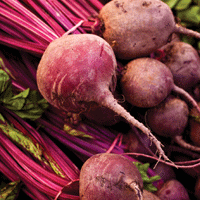Ontario’s Greenbelt Fund announces a new round of grants
Locally grown food is making the leap from quaint farmers’ markets to institutions serving thousands of diners with a boost from the Ontario government’s Greenbelt Fund Broader Public Sector Investment Fund.
Among the 15 new projects, Niagara’s Vineland Research and Innovation Centre is growing ethnic produce for chefs; George Brown College (GBC) culinary students are learning to pickle beets; Ontario’s independent meat processors are putting more meat on the menu and the Metro Toronto Convention Centre plans to pair more local food with local wine.
“There’s a host of new Canadians we fail to serve in our restaurants, grocery stores and university cafeterias,” says Jim Brandle, CEO, Vineland, one of several institutions that recently received a Greenbelt grant. “They want yard-long beans, okra, baseball – sized eggplant, kaddo and callaloo, and we’re going to make that possible.”
Acquiring seeds from around the world and growing them here is just the first step, says Brandle. Vineland conducts extensive consumer tests to ensure it’s growing the exact variety, size, shape, colour and taste the market is looking for before giving seeds to farmers to plant in test plots.
The $25,000 grant will help Vineland bring the entire value chain together, from grocery stores to big institutional food providers. Together, they’ll determine the size of the market for these world crops and how best to distribute them.
“Let’s get everybody connected at the start rather than at the end,” Brandle says. “There’s a whole lot of people who want those yard-long beans, and there are all sorts of ways to deliver them 12 months a year, from in-season fresh to big frozen totes.”
Meanwhile, at George Brown College in downtown Toronto, 35 culinary students have volunteered to learn how to can and preserve fresh local produce in the college’s new food-processing operation. Starting in October and lasting until Christmas, the students will preserve 300 litres a day using newly purchased equipment under the guidance of a chef, two food scientists and an army of in-house advisors.
The handful of items produced will be sold within the college and to the program’s 10 partners, says Chandi Jayawardena, associate dean for the Centre for Hospitality and Culinary Arts. For example, The Fairmont Royal York hotel has provided a recipe for cranberry sauce to accompany its Christmas turkey, while other partners have requested pickled beets, spiced beans and caponata, an Italian eggplant dish. A documentary of the project is also in the works.
The $200,000 grant also allows the college to hire a student to audit its food and beverage purchases — worth $3.2 million a year, including $800,000 in fresh produce — to determine how much of it is produced in Ontario. By the end of the financial year, the college will have a clear idea of how much local produce it uses. It plans to increase that amount by five to 10 per cent a year.
Teaching GBC students the importance of local food can impact the attitudes of 700 future chefs a year, Jayawardena says. “At the end of the day, this project combines the mission of the college and the funding agency. It’s a win-win solution.”
Fresh produce isn’t the only sector getting help. In the next six months, the non-profit Ontario Independent Meat Processors (OIMP) in Guelph will be surveying foodservice distributors and major foodservice operators in areas such as healthcare and education to find out what they need and to determine how best to get more of Ontario’s beef, chicken, pork, veal, lamb and turkey on their menus.
“We are confident we will see long-term results, including stronger business relationships along the value chain and subsequent increases in market opportunities,” says Heather Nahatchewitz, OIMP’s marketing and communications director.
To show the world that good things really do grow in Ontario, starting next year, The Metro Toronto Convention Centre plans to give its meetings and conventions guests a taste of local food paired with the province’s award-winning wines and other beverages.
“We have two million visitors a year,” says marketing manager, Christine Tse. “When we work with clients, we’ll be telling them what ingredients are freshest at that time of year to help them customize their menu.” Tse says the convention centre will be working with the Ontario Culinary Tourism Alliance and hiring a food and beverage procurement officer to train staff and source the best local products.
The monthly Go Local feature is an editorial partnership between Foodservice and Hospitality magazine and The Ontario Greenbelt Fund.
More in Feature Articles:
Start me Up: Uncovering What’s Big in Small Plates
Building an Empire: Profiling Lidia Bastianich
What’s Next for Grant Achatz and Nick Kokonas
In the Deep: Wading Through the World of Deep Fryers
Straight Shooter: Profiling Chef Neil Taylor





















